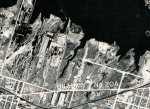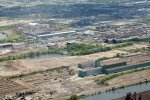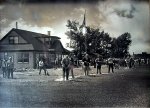Hello all,I am looking for general information about an airport that was located at the north end of parkdale ave. I think a fellow named elliot owned it.I used to wander the marshes down there in the early 50's, I came across some old runways. There was also a gun club in the area,I used to pick up all the old clay pigeons.Not sure but I think there was an old house where the Windemere cut off started,on the bay side. that was when the Beach road ran straight through to the QEW,which had stop lights at the time. thanks for any information. jayc
airport
- Thread starter jayc
- Start date
Jay;
I can help you out on a couple of the requests and hopefully one of the history members can chime in.
The marsh area is now what we call Harris Inlet, the Port Authority wanted to fill it all in last year and Beach resident Jim Howlett started a movement of sorts to stop it, see here-
http://hamiltonbeachcommunity.com/forum/showthread.php?t=1157
I have many more pictures of what the Inlet looks like now if wanted.
The Hamilton Gun Club was located beside this inlet and moved many years ago up to Hwy 20, near Hwy 53. I stopped in there one day and they let me scan a picture of the old club that was hanging on the wall. I have attached that picture below.
There is another thread that references the Black Bridge, it shows a pretty good view of the surrounding area. See here-
http://hamiltonbeachcommunity.com/forum/showthread.php?t=522
As for the airport, the best info I can come with is from two books, "Hamilton Back Then" and "Vanished Hamilton" Both have pretty good write ups on the old east end airport.
An article from the Spec;
http://www.thespec.com/news-story/2261962-memories-of-the-east-end-air-show/
I can help you out on a couple of the requests and hopefully one of the history members can chime in.
The marsh area is now what we call Harris Inlet, the Port Authority wanted to fill it all in last year and Beach resident Jim Howlett started a movement of sorts to stop it, see here-
http://hamiltonbeachcommunity.com/forum/showthread.php?t=1157
I have many more pictures of what the Inlet looks like now if wanted.
The Hamilton Gun Club was located beside this inlet and moved many years ago up to Hwy 20, near Hwy 53. I stopped in there one day and they let me scan a picture of the old club that was hanging on the wall. I have attached that picture below.
There is another thread that references the Black Bridge, it shows a pretty good view of the surrounding area. See here-
http://hamiltonbeachcommunity.com/forum/showthread.php?t=522
As for the airport, the best info I can come with is from two books, "Hamilton Back Then" and "Vanished Hamilton" Both have pretty good write ups on the old east end airport.
An article from the Spec;
http://www.thespec.com/news-story/2261962-memories-of-the-east-end-air-show/
Attachments
-
197.2 KB Views: 86
-
384.5 KB Views: 92
-
350.1 KB Views: 76
-
320.8 KB Views: 76
Last edited:
Jake
"Hello all,I am looking for general information about an airport that was located at the north end of parkdale ave. I think a fellow named elliot owned it.I used to wander the marshes down there in the early 50's, I came across some old runways. There was also a gun club in the area,I used to pick up all the old clay pigeons.Not sure but I think there was an old house where the Windemere cut off started,on the bay side. that was when the Beach road ran straight through to the QEW,which had stop lights at the time. thanks for any information. jayc
Hi Jake,
This Hillcrest School history page has some information about an airport. I don't know if it's what you're looking for.
After some citizens (Joseph Bairstow, F. Gartrell, and T. Lester) applied for a new school to be built, a site was chosen, that was 3/4 mile east of Parkdale Avenue on the south side of Barton Street.
In 1929, the Hamilton Civic Airport (Municipal Airport) was opened in what is now the area between Hillcrest and Parkdale Avenue. The airport was built behind the school extended to Parkdale Avenue, and would have came within a few hundred feet of the school today. The airport was built by International Airways Ltd., and the Hamilton Aero Club.
http://schools.hwdsb.on.ca/hillcrest/about/history/
"Hello all,I am looking for general information about an airport that was located at the north end of parkdale ave. I think a fellow named elliot owned it.I used to wander the marshes down there in the early 50's, I came across some old runways. There was also a gun club in the area,I used to pick up all the old clay pigeons.Not sure but I think there was an old house where the Windemere cut off started,on the bay side. that was when the Beach road ran straight through to the QEW,which had stop lights at the time. thanks for any information. jayc
Hi Jake,
This Hillcrest School history page has some information about an airport. I don't know if it's what you're looking for.
After some citizens (Joseph Bairstow, F. Gartrell, and T. Lester) applied for a new school to be built, a site was chosen, that was 3/4 mile east of Parkdale Avenue on the south side of Barton Street.
In 1929, the Hamilton Civic Airport (Municipal Airport) was opened in what is now the area between Hillcrest and Parkdale Avenue. The airport was built behind the school extended to Parkdale Avenue, and would have came within a few hundred feet of the school today. The airport was built by International Airways Ltd., and the Hamilton Aero Club.
http://schools.hwdsb.on.ca/hillcrest/about/history/
From "A Mountain and a City" by Marjorie Freeman Campbell;
Probably the first birdman in the city was youthful Jack Burton whose optimistic glider launching from the mountaintop carried him to hospital. At the first 1911 air meet in Hamilton where Canadian pilot J. A. Douglas McCurdy defeated American Charles F. Willard by flying a speedy 35 miles in 36 minutes, a second flier came to grief, British flying instructor J. V. Martin's dive into the swamp off the Beach Road incidentally providing a future noted Hamilton airman with his introduction to flying. For dismantling and carrying out parts of the downed Farman machine, eleven-year-old Robert Dodds and his brother each received a dollar. Officially, commercial flying in the city was inaugurated by Dundas-born Jack V. Elliott who reportedly traded a fast racing car in 1922 for a Curtis Canuck; qualified at Borden as pilot and air engineer; with war surplus parts built two additional machines in a workshop on the bay front at MacNab Street; and began promoting air mindedness by offering short flights at a small fee.
At a flying field on the mountain and later on the Niagara highway, hundreds gathered on Sunday afternoons to watch the planes. With the Red Lake gold rush of 1926 aviation began to pay off. Elliott shipped two machines to Hudson, twelve days by dog team from the mining area but only two hours by air, and ferried prospectors in and out for $1,000 one way. He was appointed postmaster and Elliott airmail stamps are a collector's item today. Later he amalgamated with Fairchild as Elliott-Fairchild Air Service.
The following spring with five planes he opened the Beach Road airport and private flying school, using the old Ghent homestead as clubhouse. The first in Canada, the school received entrants from all parts of this country and the United States. Miss Eileen Vollick, the first Canadian woman to obtain a flier's license, was a pupil.
On August 24th, 1927, the first official air mail for Hamilton was received at the field. Flown by pilot Earl Hand, the mail was met by Postmaster John A. Webber2 who arrived by horse and buggy. Followed by a crowd of spectators Mr. Webber advanced down Beach Road to watch the seaplane land on the bay and taxi up the lagoon east of the Firestone plant. Following its receipt the postmaster telephoned the post office announcing the arrival and amount of the mail.
When Jack Elliott sold his fleet of twenty-one amphibians, cabin planes and scout machines in 1928 to International Airways (president, R. O. Denman, D.C.M., M.M.), he was known across Canada. His countrywide barnstorming had resulted in his charting many of the routes and landing fields later used in aviation.
Another, less successful, service had been instituted in Hamilton by Mr. Elliott. On May 20th, 1922, Herbert Slack, owner of Wentworth Radio and Supply Company, went on the air with radio station CKOC, third station in the province. Two years later The Hamilton Spectator took a first step in the same field with station CHCS, sharing CKOC's wavelength, and broadcasting nightly newscasts and Sunday church service. The following year Elliott opened station CFCU from a studio on King Street West. Both CHCS and CFCU were later discontinued while CKOC flourished.
Shortly after sale of his business Jack Elliott moved to Owen Sound. In Hamilton his place was taken by the Hamilton Aero Club, started in 1927 by several first war pilots and chartered in 1928 with Major Robert Dodds, M.C., founder and first president. Occupying the old Stewart Park on Beach Road, a few fields from Elliott's site, the Aero Club began functioning with two machines loaned by the government. With the R.C.A.F. officially created only on April 1st, 1924, the need for trained pilots led the government to donate a plane for each machine purchased by the club and to pay $100 for each pilot graduated. By the year's end the club was able to purchase a new Gypsy Moth, with the government matching this and also paying for several pilot graduates.
In 1929, when the Hamilton Municipal airport was opened on the east side of Parkdale Avenue between Main Street (now Queenston Road) and Barton, Aero Club members numbered 133, with 52 taking instruction. Its executive included president, Lloyd H. Smith; vice-president, Beamer W. Hopkins, later chief magistrate, police commissioner and president of the Hamilton citizenship court, airman in the First World War and air commander in the second; secretary, Marshall J. Lounsbury; treasurer, William H. Acres; and a director, the late Samuel S. Foley, M.B.E., later regional director of air services for Ontario. In charge of instruction was Robert Dodds, a First World War member of the fledgling Royal Flying Corps — the later R.A.F. — who was rated by The National Geographic as among the top twenty British airmen of the war, credited with destroying eleven enemy planes in aerial encounters. For "conspicuous gallantry and devotion to duty" he was decorated by King George V.
A joint effort of Hamilton and International Airways Limited, with the Hamilton Aero Club assisting, the 200-acre airport was hailed as an outstanding example of community foresight and cooperation. It was opened by the Hon. G. Howard Ferguson and Mayor William Burton, a feature being the institution of airmail service by Canadian Airways, the first Hamilton mail leaving the airport on Friday, June 7th.
In 1929 International Airways was absorbed by Canadian Airways Limited, which later became Canadian Pacific Airlines, and the office moved to Montreal.
Probably the first birdman in the city was youthful Jack Burton whose optimistic glider launching from the mountaintop carried him to hospital. At the first 1911 air meet in Hamilton where Canadian pilot J. A. Douglas McCurdy defeated American Charles F. Willard by flying a speedy 35 miles in 36 minutes, a second flier came to grief, British flying instructor J. V. Martin's dive into the swamp off the Beach Road incidentally providing a future noted Hamilton airman with his introduction to flying. For dismantling and carrying out parts of the downed Farman machine, eleven-year-old Robert Dodds and his brother each received a dollar. Officially, commercial flying in the city was inaugurated by Dundas-born Jack V. Elliott who reportedly traded a fast racing car in 1922 for a Curtis Canuck; qualified at Borden as pilot and air engineer; with war surplus parts built two additional machines in a workshop on the bay front at MacNab Street; and began promoting air mindedness by offering short flights at a small fee.
At a flying field on the mountain and later on the Niagara highway, hundreds gathered on Sunday afternoons to watch the planes. With the Red Lake gold rush of 1926 aviation began to pay off. Elliott shipped two machines to Hudson, twelve days by dog team from the mining area but only two hours by air, and ferried prospectors in and out for $1,000 one way. He was appointed postmaster and Elliott airmail stamps are a collector's item today. Later he amalgamated with Fairchild as Elliott-Fairchild Air Service.
The following spring with five planes he opened the Beach Road airport and private flying school, using the old Ghent homestead as clubhouse. The first in Canada, the school received entrants from all parts of this country and the United States. Miss Eileen Vollick, the first Canadian woman to obtain a flier's license, was a pupil.
On August 24th, 1927, the first official air mail for Hamilton was received at the field. Flown by pilot Earl Hand, the mail was met by Postmaster John A. Webber2 who arrived by horse and buggy. Followed by a crowd of spectators Mr. Webber advanced down Beach Road to watch the seaplane land on the bay and taxi up the lagoon east of the Firestone plant. Following its receipt the postmaster telephoned the post office announcing the arrival and amount of the mail.
When Jack Elliott sold his fleet of twenty-one amphibians, cabin planes and scout machines in 1928 to International Airways (president, R. O. Denman, D.C.M., M.M.), he was known across Canada. His countrywide barnstorming had resulted in his charting many of the routes and landing fields later used in aviation.
Another, less successful, service had been instituted in Hamilton by Mr. Elliott. On May 20th, 1922, Herbert Slack, owner of Wentworth Radio and Supply Company, went on the air with radio station CKOC, third station in the province. Two years later The Hamilton Spectator took a first step in the same field with station CHCS, sharing CKOC's wavelength, and broadcasting nightly newscasts and Sunday church service. The following year Elliott opened station CFCU from a studio on King Street West. Both CHCS and CFCU were later discontinued while CKOC flourished.
Shortly after sale of his business Jack Elliott moved to Owen Sound. In Hamilton his place was taken by the Hamilton Aero Club, started in 1927 by several first war pilots and chartered in 1928 with Major Robert Dodds, M.C., founder and first president. Occupying the old Stewart Park on Beach Road, a few fields from Elliott's site, the Aero Club began functioning with two machines loaned by the government. With the R.C.A.F. officially created only on April 1st, 1924, the need for trained pilots led the government to donate a plane for each machine purchased by the club and to pay $100 for each pilot graduated. By the year's end the club was able to purchase a new Gypsy Moth, with the government matching this and also paying for several pilot graduates.
In 1929, when the Hamilton Municipal airport was opened on the east side of Parkdale Avenue between Main Street (now Queenston Road) and Barton, Aero Club members numbered 133, with 52 taking instruction. Its executive included president, Lloyd H. Smith; vice-president, Beamer W. Hopkins, later chief magistrate, police commissioner and president of the Hamilton citizenship court, airman in the First World War and air commander in the second; secretary, Marshall J. Lounsbury; treasurer, William H. Acres; and a director, the late Samuel S. Foley, M.B.E., later regional director of air services for Ontario. In charge of instruction was Robert Dodds, a First World War member of the fledgling Royal Flying Corps — the later R.A.F. — who was rated by The National Geographic as among the top twenty British airmen of the war, credited with destroying eleven enemy planes in aerial encounters. For "conspicuous gallantry and devotion to duty" he was decorated by King George V.
A joint effort of Hamilton and International Airways Limited, with the Hamilton Aero Club assisting, the 200-acre airport was hailed as an outstanding example of community foresight and cooperation. It was opened by the Hon. G. Howard Ferguson and Mayor William Burton, a feature being the institution of airmail service by Canadian Airways, the first Hamilton mail leaving the airport on Friday, June 7th.
In 1929 International Airways was absorbed by Canadian Airways Limited, which later became Canadian Pacific Airlines, and the office moved to Montreal.



